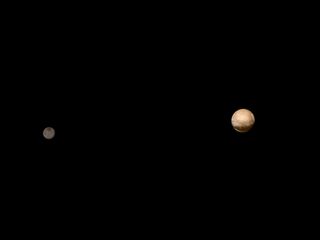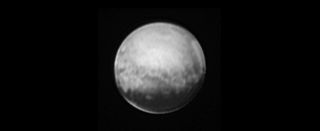
New photos by NASA's approaching New Horizons probe capture Pluto and its largest moon, Charon, in fascinating detail.
The new images — which were taken late Wednesday (July 8) from a distance of 3.7 million miles (6 million kilometers) — show that Pluto and Charon are very different bodies, though they circle a common center of gravity and are separated by a mere 12,200 miles (19,640 km), NASA officials said.
"These two objects have been together for billions of years, in the same orbit, but they are totally different," New Horizons principal investigator Alan Stern, of the Southwest Research Institute (SwRI) in Boulder, Colorado, said in a statement. [New Horizons Probe's July 14 Pluto Flyby: Complete Coverage]

At 750 miles (1,200 km) in diameter, Charon is about half was wide as Pluto itself. The two bodies' center of mass lies outside the dwarf planet, so many researchers regard Pluto-Charon as a binary system. (Pluto has four other moons — Nix, Hydra, Kerberos and Styx — all of which are tiny.)
Most scientists think the dwarf planet system was shaped long ago by a huge collision between a proto-Pluto and and proto-Charon. Those two objects were apparently quite different from each other, based on the characteristics of modern Pluto and modern Charon.
For example, Pluto sports a reddish-orange hue, while Charon is quite gray. And New Horizons' observations leading up to its epic July 14 Pluto flyby have already shown that the dwarf planet's surface is a complex blend of bright and dark features, including one marking that looks like a giant heart and another that mission team members have dubbed "the whale." Meanwhile, Charon is more uniform (with the notable exception of a mysterious dark polar cap).
The new photos reveal light patches on Charon that might be craters, mission team members said.
Get the Space.com Newsletter
Breaking space news, the latest updates on rocket launches, skywatching events and more!

"If we see impact craters on Charon, it will help us see what's hidden beneath the surface," Jeff Moore, of NASA's Ames Research Center in Moffett Field, California, said in the same statement.
"Large craters can excavate material from several miles down and reveal the composition of the interior," added Moore, who leads New Horizons' geology, geophysics and imaging (GGI) team.
Indeed, the new images serve as a reminder that Pluto isn't the only game in town for New Horizons.
"Charon is now emerging as its own world," said GGI deputy team leader John Spencer, of SwRI. "Its personality is beginning to really reveal itself."
During the July 14 flyby, New Horizons will zoom past Pluto at a distance of 7,800 miles (12,500 km), capturing the first-ever close-up views of the dwarf planet and Charon.
Follow Mike Wall on Twitter @michaeldwall and Google+. Follow us @Spacedotcom, Facebook or Google+. Originally published on Space.com.
Join our Space Forums to keep talking space on the latest missions, night sky and more! And if you have a news tip, correction or comment, let us know at: community@space.com.

Michael Wall is a Senior Space Writer with Space.com and joined the team in 2010. He primarily covers exoplanets, spaceflight and military space, but has been known to dabble in the space art beat. His book about the search for alien life, "Out There," was published on Nov. 13, 2018. Before becoming a science writer, Michael worked as a herpetologist and wildlife biologist. He has a Ph.D. in evolutionary biology from the University of Sydney, Australia, a bachelor's degree from the University of Arizona, and a graduate certificate in science writing from the University of California, Santa Cruz. To find out what his latest project is, you can follow Michael on Twitter.
